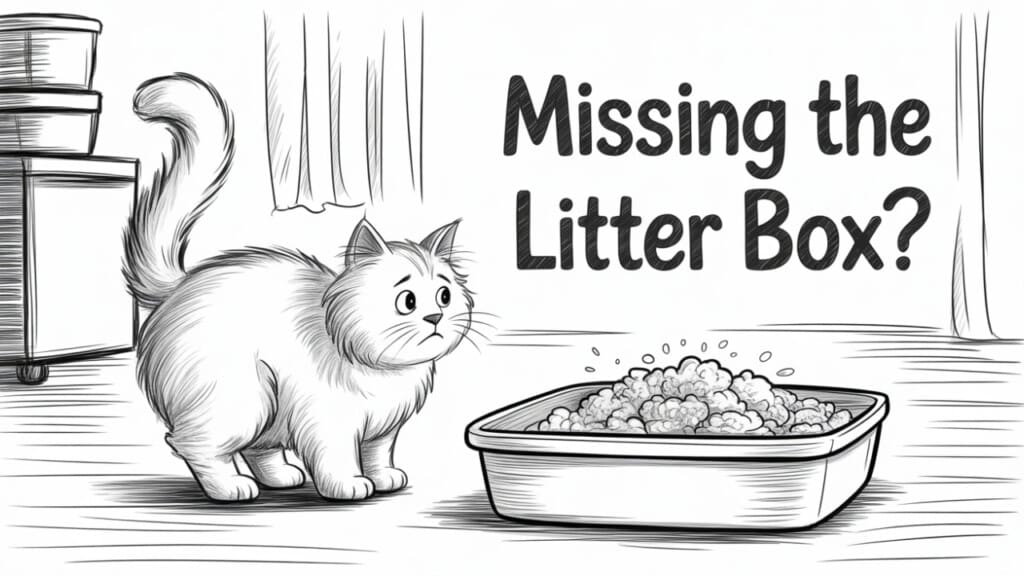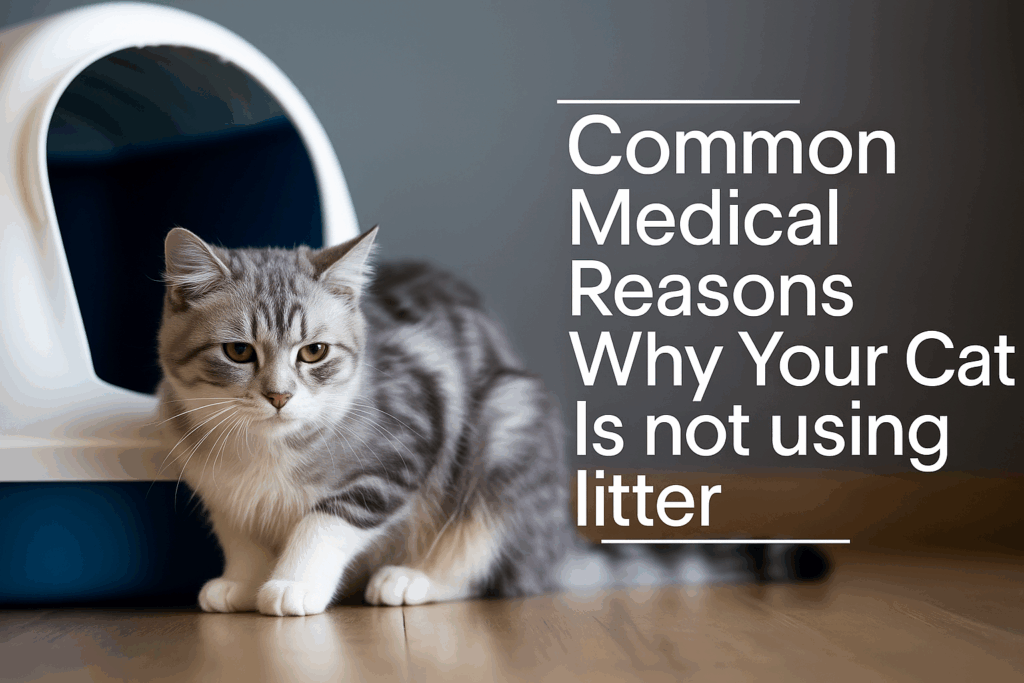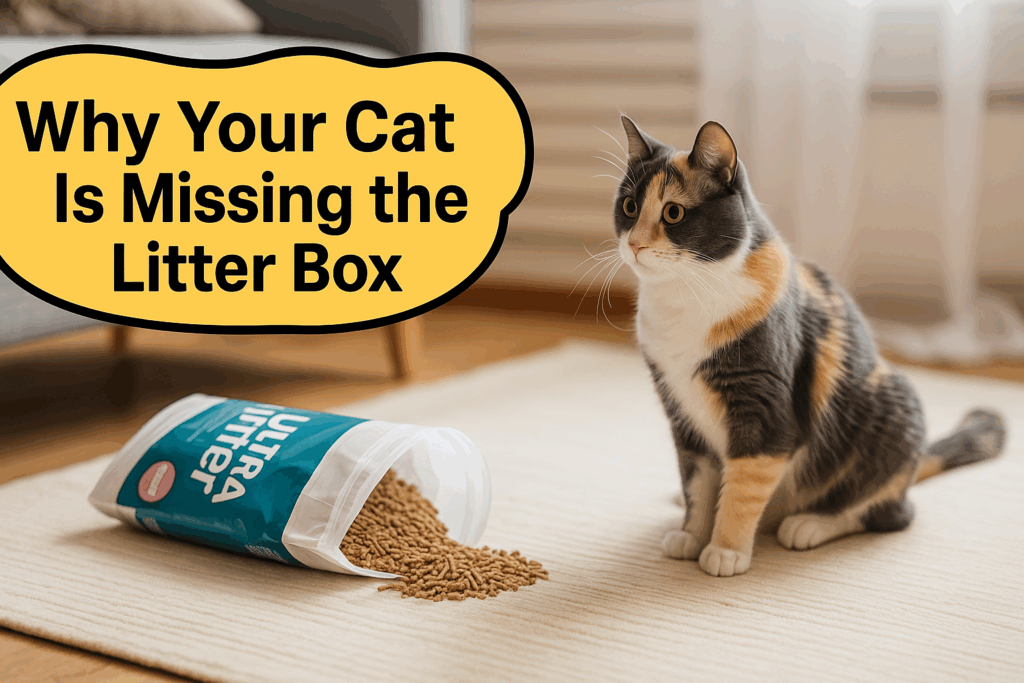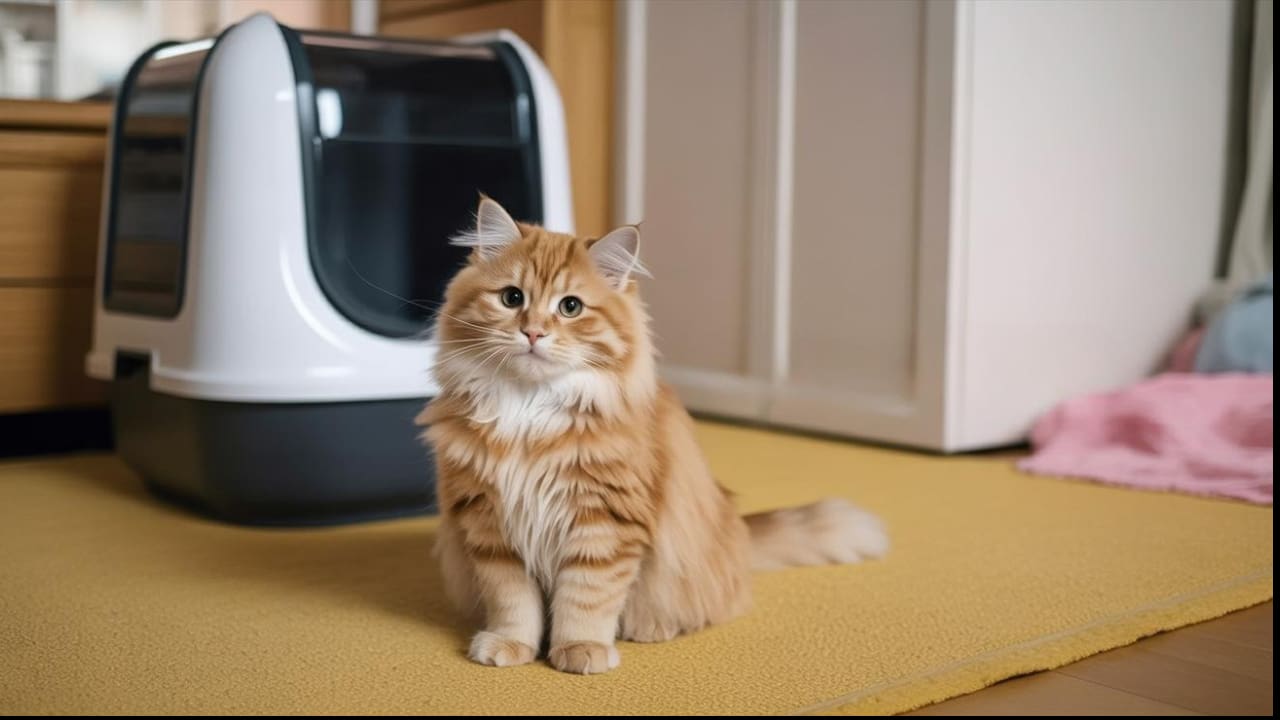Your Cat Is Missing the Litter Box? Expert Guide to Causes, Vet-Backed Fixes, Setup Tips & Myths to Avoid
The litter box is right there. Same place as it’s always been. But your cat just keeps ignoring it. Instead, you may detect odor around your plants, then your couch, and your mat… Your house stinks.
There’s probably a good reason why your cat is missing the litter box. The avoidance may be because of urinary tract infection, environmental stress, the box itself, or even something like litter box placement.
For example, if you place the litter tray near a noisy place, your cat will probably not like it. Even we humans can’t relax in such an environment.
You need to learn to read your cat’s behavior. Observe them. Does your baby react to a dirty litter box? Do you see any issues while they walk? Maybe it’s affecting their ability to get into the box…
After that, you can focus on fixing the issue. And we’re here to help.
This guide will walk you through the most common medical, behavioral, and environmental reasons behind litter box avoidance. We’ll also look into things like litter box setup, when you need to see a vet, and myths surrounding the issue.
Litter Box mistake quiz.
1. How many litter boxes do you have?
2. Where are boxes located?
3. What litter type do you use?
4. How often is waste removed?
5. Does your cat show pain signs?
Your Setup Score: 0/15
Understanding Why a Cat Is Missing the Litter Box

Our cats are incredibly attentive to detail. So, if they’re missing that litter box, most likely something’s wrong. It could be physical, emotional, or even environmental. We are frustrated, of course. But know that our feline friends are not doing it on purpose… most of the time.
One reason your cat is missing the litter box is probably discomfort. By that, we’re talking urinary bladder infection, bladder inflammation, or even arthritis. Basically pain. And when that pain hits while your cat is eliminating in the box, they start associating the two, so that the litter box equals pain. And they start avoiding the box.
Then, there’s your senior cat. Chances are, your aging friend here is experiencing cognitive decline. So it’s likely that they just forgot where the box is. Or they could be facing problems reaching it in time. That’s why placement is important.
Behavioral factors are another thing. Change in household dynamics, for example. Your cat may be trying to adapt to your new pet. Their territorial behavior or conflicts could lead them to avoid sharing or even using the box.
Maybe you’re moving into a new place. Or maybe it’s the loud noises near the litter box. These things can make your cat stressed out.
It’s likely that your cat has attempted to communicate with you, trying to tell you what’s wrong. But perhaps you didn’t catch it.
So, now you’re here learning to recognize the signs and interpreting your cat’s message.
Common Medical Reasons Your Cat Is Missing the Litter Box

If your baby is usually clean and consistent, but they start avoiding the litter box one day, you can probably blame medical issues for it.
One common cause is urinary bladder infection (UTI). This causes pain, urgency, and makes your cat want to urinate a lot more often. And that makes it difficult for your cat to hold out until they reach the box. Bladder stones or cystitis is another similar, painful culprit.
Arthritis or joint pain is another possible cause to blame, especially in older cats. If getting into the box becomes a painful experience (i.e. raising their legs), your baby may just opt for an easier route, like your plant, for example.
If your cat is suffering from diabetes or kidney disease, they may also urinate more, and likely in larger volumes. So if you don’t clean that litter box often, they won’t like it.
Then, there’s cognitive dysfunctional syndrome. We can call it dementia for cats. As the name suggests, your cat could just be disoriented or suffering from memory lapses. In other words, they forget where the box is or aren’t sure how to use it correctly.
Pain Assessment Guide for Cats Missing the Litter Box
Your cat is likely in pain if they’re avoiding the litter box. Learn to watch their body language. It might be a medical condition.
For arthritis-related pain, look for these signs:
– The “Arthritis Squat.” You may see their tail hanging low and legs looking stiff when they approach or leave the litter box.
– A hunched back with their abdomen tucked in. This can mean your cat is having trouble moving because of joint pain.
– Your cat may rest with feet curled underneath. This could be a sign of discomfort in joints that bear weight.
– If your cat is reluctant to jump up or down, they may be avoiding movements that hurt their joints.
For UTI or bladder pain, signs include:
– A hunched posture while urinating, with a tense, arched back.
– Frequent squatting but only a small amount of urine or none at all.
– Vocalizing during elimination, like crying or growling while using the litter box.
– Excessive licking of the genital area after peeing, which can be due to pain or irritation.
Veterinarians use special tools to measure pain. One is the Glasgow Feline Composite Measure Pain Scale (CMPS-Feline), which goes up to 20 points – scores of 5 or more mean pain relief may be needed. Another is the Feline Grimace Scale, which checks 5 facial expressions. A score of 4 out of 10 or more means your cat likely needs pain management.
Behavioral Causes as to Why Your Cat Is Missing the Litter Box

Now, we can’t blame everything on medical reasons. Sometimes (or perhaps most of the time), your cat’s elimination issue may be behavioral.
The most common cause is probably stress or anxiety. Your cat can feel it. The new home, rearranged furniture, a new pet, or even a human baby. Sometimes it can be something as obvious as conflict between your pets.
In response, your cat may pee outside the box to mark their territory. And it’s also a way to express distress. That’s why you see your cat keeps missing the litter box by just a few inches. They’re not fully rejecting it. Just uneasy, not comfortable using it.
Negative association is the thing too. Pain plus urination equals bad experience, whether from illness or injury. Once the pain gets associated with peeing in the box, you’ll see litter box avoidance.
Loud noises and chaotic footsteps can also make your baby feel unsafe or exposed. Your cat, like you (probably), just wants a quiet place to do their business… peacefully.
Then, there’s the multi-cat households for you cat ladies. You seriously need to think whether your cats are bullying or resource guarding. Does one of them hog the box and prevent others from using it? Are there enough litter boxes for all of your cats? Keep a sharp eye on them.
Environmental Triggers: How Setup Affects Litter Box Use
The environment may also have a role to play here. Essentially, you need to make sure that the litter box is up to standards for your cats’ use.
One thing you need to look into is litter box placement. Our cats like quiet, low-traffic areas when minding their business. So make sure there aren’t any noisy appliances nearby. And avoid placing food and water near the box too. Seriously, gross. Tight corners? Also a no.
The type and size of the box, too, are a concern. Make sure the box is not too small and not too hard to enter. It drives the ones with joint pain away, and you can probably see that your cat keeps missing the litter tray.
You also want the litter box to be clean enough. Your cat has a sensitive nose, so a dirty box will drive them away. And be more attentive when switching brands. Some cats may reject the new texture or just stay confused for a while.
Lastly, if your baby is an outdoor cat, that might have something to do with the issue too. They may be too used to eliminating in soil or mulch. But they can’t find the same texture in their litter box.
Step-by-Step Litter Box Solutions That Work
We understand. You’re probably still asking the question, “Why does my cat keep missing the litter box?” Don’t fret and step back a little. Let’s try following some step-by-step cat missing litter box solutions in this section.
A methodical and structured plan can likely help you re-establish positive litter box habits. After all, you want to reduce stress for both yourself and your little one(s).
Step 1: Rule out medical issues. This is especially important if your cat is missing the litter box when peeing. Check with a vet as soon as possible.
Step 2: Optimize box placement. Choose a quiet location. No noisy appliances, no foot traffic, no food or water nearby. And make sure each cat has their own space.
Step 3: Increase litter box availability. One box per cat, plus one extra (catchy eh?). Spread them out across different areas. You can avoid tension this way.
Step 4: Adjust the box itself. The litter box should be large enough. Choose low-sided boxes. Consider switching to a wider or uncovered model.
Step 5: Choose the right litter. Unscented, fine-grain litters are the way to go. When switching litters, try mixing the old ones with the new litter. Do a gradual transition over 6-7 days, starting with 25% new litter and gradually increasing to 100%.
Step 6: Maintain cleanliness. Clean the waste at least once every day. Do a full litter change every week. You don’t want to wait.
Step 7: Reinforce good behavior. Praise your cat gently or offer a treat when they use the box right. Never punish. You might earn yourself a rebellious furball otherwise.
Myths About Why Your Cat Is Missing the Litter Box
Many common beliefs about litter box avoidance come from myth. You don’t want to be misled by those.
One persistent myth out there is that cats pee outside the litter box out of spite. Really, your cat isn’t likely to act out of revenge. They are probably just communicating or expressing their needs and discomfort.
Next is punishment. Yelling at or scolding your cat won’t solve the root problem. It can even make your little one stressed out. This can make things far worse than you can imagine. Remember, cats are not humans. They don’t associate punishment with past actions. Be calm and consistent in setting up a routine.
A single litter box is not enough for all the cats you have in the house. So don’t listen to people asking you to make your cats share a box. Territorial, sensitive, and prideful cats don’t do well with sharing.
Another thing is the belief that cats “just know” where to go. Goodness. That’s not true. And it’s especially not so for kittens, new rescues, and senior cats with memory decline. They need extra support from you.
Cat Is Missing the Litter Box: When to Seek Veterinary or Behavioral Help
There are definitely times when your cat keeps missing the litter box when peeing, no matter what you do. So, you might want to see a vet or even a feline behaviorist for help. Look out for the signs to tell you when to start making an appointment.
If you see your cat straining, if there’s blood in the urine, or if your cat is vocalizing their pain, it’s quite clear. These could be symptoms of a urinary tract infection, bladder inflammation, or other medical concerns. Don’t hesitate and call your vet.
If your cat is medically okay, but still avoids the box? See a certified feline behaviorist. They are experts at analyzing cat behavior. A good one can help you uncover reasons associated with home dynamics, stress triggers, and even issues with litter box setup.
You also most likely need outside expertise for chronic issues. These include box avoidance for weeks, returning to the same inappropriate spot, or missing the box even after following all recommended changes.
Preventing Future Litter Box Problems Before They Start
Before getting to this possible future, perhaps it’s best we prevent it from happening. So, start by creating a stable, cat-friendly environment now.
Get the right litter box setup. Make sure it’s open, spacious, with unscented, fine-grain litter. Make sure the box is clean. And maybe observe if your cat likes the box size and location.
Definitely choose a quiet place with a good amount of privacy. You don’t want your cat to stress out while eliminating in a noisy environment. We know we wouldn’t want that (or maybe most of us). And make sure you have enough boxes set up in different parts of the house. One box per cat, plus one extra.
Routine vet checkups too. If you want prevention, you’ll want to detect subtle health changes. Catch them early, and you’ll face fewer issues in the future.
Lastly, beware of environmental stressors. Changes in schedule, household dynamics, or even a new scent may affect your pussy friend. Try offering enrichment through play. You can get a scratching post and establish a stable routine to calm your cat.
Can a Cat Survive Without a Litter Box?
Well, a little box is not a must-have. That goes for our human bathroom, right? But it’s not exactly healthy for domestic settings.
Where would you expect your cat to eliminate their waste if they don’t have a designated place to do so? You can’t complain about your cat spraying in corners, rugs, or furniture then.
Your cat may even hold their urine or feces without a place to go. And that means higher risks for urinary tract infections, bladder inflammation, or constipation.
Even outdoor or semi-outdoor cats could use a nice litter box inside the house. It’s a good backup for bad weather, aging, or illnesses. Basically, if they can’t go out, they can still do it in the house without holding it in.
The First Step May Just Be High-Quality Litter. How Dr. Elsey’s Solves Real Litter Box Problems
The quality of your cat’s litter matters. And we’d say that it’s probably just as important (if not more important) as the litter box. After all, you can’t expect your cat to love their box when they don’t even like stepping onto the litter or they sneeze every few seconds while in their box.
Also, house soiling can make some of us too frustrated. And the result is usually cats being abandoned or surrendered to shelters. It’s heartbreaking, but quite a common thing. So, consider getting some high-quality litter.
Now, we’ve found two products from Dr. Elsey’s, specifically the Crystal Attract® Litter and Cat Attract® Litter, to be suitable for our feline friends and to help with house soiling issues.
These litters are designed with real cat behavior in mind. They contain a natural herbal attractant that encourages cats to return to their litter boxes. And, they are low-dust, unscented, and good for odor control.
The Crystal Attract® Litter is made from low-tracking, non-toxic silica crystals that do not stick to long-haired coats and are especially gentle on sensitive paws. The Cat Attract® Litter uses hard-clumping clay, with the ideal texture and granule size that appeals to picky cats.
Dr. Elsey’s is a company founded by Dr. Bruce Elsey (a veterinarian) and his wife, Kathy, back in 1987. They prioritize helping cats stay in loving homes and run the company with a “pets before profit” approach.
They now focus their efforts on developing quality litter and clean protein foods and treats to support healthy homes and pets. They test their products in feline rescue clinics, donate free litter to shelters, and have created a fund for supporting cancer research.
Frequently Asked Questions About Litter Box Avoidance
1. Why does my cat forget where the litter box is?
If your cat is old or suffering from cognitive decline, then they may forget the routine location. This is especially the case if you’ve recently moved it to a new location. Or if your household has changed.
2. Can cats smell their litter box if lost?
Cats have a powerful nose, so they can usually detect their litter box. But overwhelming scents or recent cleanings may mask these familiar cues for a while.
3. What if my cat stops using the litter box?
If it’s a sudden thing, talk to a vet to rule out medical causes first. Then check for behavioral or environmental triggers like stress or box cleanliness. You can seek professional help too.
4. Can a cat miss the litter box?
Yes. This is especially the case for cats with arthritis and joint stiffness. Small boxes that are not appropriate for the cats can be the cause as well.
5. How long can a cat go without peeing?
Most cats need to go at least once every 24 hours. If your cat hasn’t done it in over a day, there’s probably an issue. Call for help.
6. Why is my cat missing the litter box when peeing?
It might be pain from a urinary condition. It could be limitations in mobility (arthritis or aging). It could also be the box’s setup, including location and litter type.
7. Do cats avoid the litter box out of spite?
No. Cats don’t typically act out of revenge. Litter box avoidance is likely because of discomfort, stress, fear, or unmet needs.
8. Can changing the type of litter cause accidents?
Yes, some cats hate sudden changes in litter texture or scent. So, you should try to transition slowly. This can avoid confusion or rejection.
9. Why does my cat pee right next to the box?
It’s most likely an issue with the box size, location, or cleanliness. Your cat is probably trying, but the setup is inadequate.
10. Should I punish my cat for not using the litter box?
No. You’ll only make them more stressed out and even make the problem worse. You need positive reinforcement. And you need to also find out the root problem(s).
Real Success Story: Senior Cat Litter Box Recovery
Mittens is a 14-year-old domestic shorthair tabby from Portland. This little furball started pooping just a few inches outside her litter box. It went on for 6 months, even though she had perfect habits for 12 years. Regular scooping and cleaning didn’t solve the problem.
A veterinary exam revealed that Mittens had moderate hip arthritis and early kidney disease (ISFM Stage 1). She was also observed to be avoiding the litter box due to pain.
The treatment included monthly Solensia injections to manage her arthritis pain. Her litter box was changed to a low-entry NVR Miss box with 2.5″ sides (compared to the old 6″ sides), making it easier for her to get in.
Her owner also switched to using Dr. Elsey’s Cat Attract Litter, which contains a natural attractant. And they added a second litter box on the main floor so that she didn’t have to go to the basement to relieve herself.
Here’s how Mittens improved:
- In Week 1–2, after her first Solensia injection, instances of accidents dropped by 50%.
- By Week 3–4, after switching to the low-entry box, the rate dropped to only 20%.
- At Week 6, with the new litter, she was 95% back to normal.
- From Week 8 onward, Mittens experienced no accidents.
The biggest reasons for success were:
– The pain relief effect from Solensia, which helped her move better.
– A low-entry litter box that didn’t hurt her joints.
– Dr. Elsey’s Cat Attract litter that encouraged her to use the box.
– Easier access with more litter boxes in the house
Owner Sarah M. said,
“I was ready to consider euthanasia after months of daily cleanup. The combination of treating her arthritis pain with Solensia and making the box easier to access completely changed our lives. Mittens is back to being the sweet cat I’ve loved for 14 years.”
Veterinary note: This case shows how important it is to treat medical issues and make helpful environment changes, especially for senior cats with physical challenges.
Total cost in the first month was around $165:
– $115 for Solensia,
– $35 for the new box,
– $15 for the special litter.
The result: A full recovery that has lasted more than 6 months, with just monthly Solensia injections for maintenance.
Restoring Trust and Routine: Helping Your Cat Get Back on Track
Pay attention when your cat is missing the litter box. And remember, never try to use punishment on your precious feline friend.
They are unlikely to be doing it on purpose. It could be medical discomfort, emotional stress, or an issue with the litter box setup itself.
Make sure you observe well. A clean environment could help, and professional guidance can make a big difference, especially if things get out of hand.
With understanding and the right approach, you are bound to establish or re-establish your cat’s stress-free litter habit. Tread confidently and always be patient and compassionate towards your furry baby.
Have you ever had to deal with your cat suddenly avoiding the litter box? What happened and how did you handle it? Share your story with us in the comments down below.








